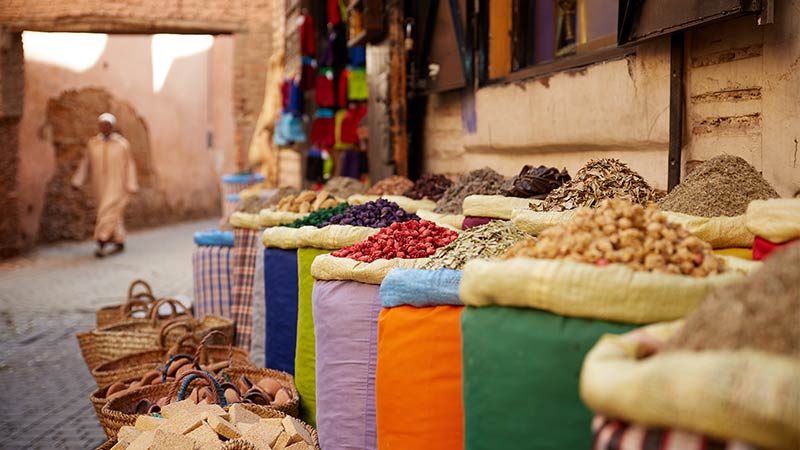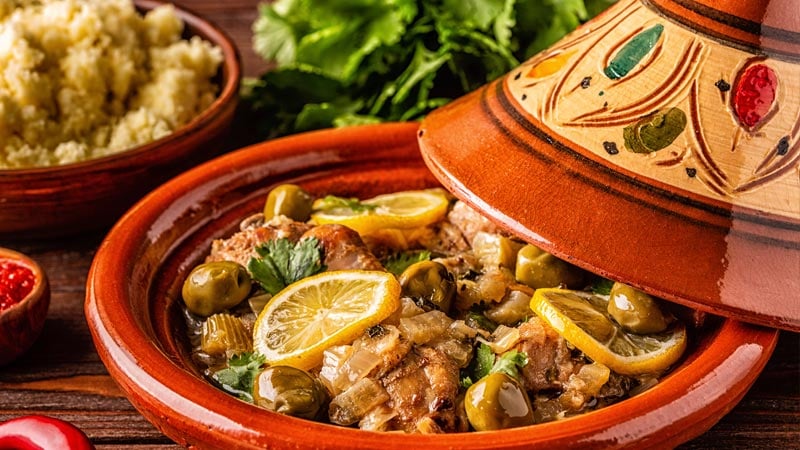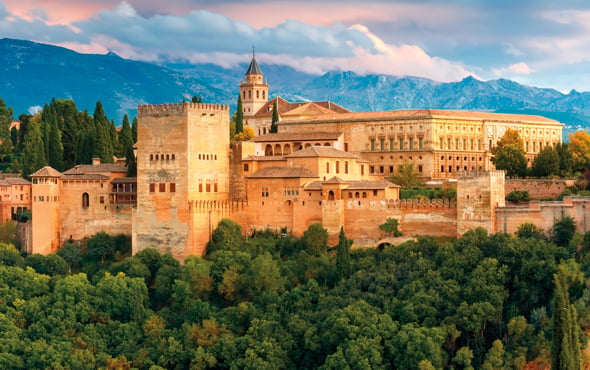Inspiration
Spices of the Souk: Moroccan Flavors at Home
An exotic mix of sweet, spicy and smoky aromas will wash over you before you even set eyes on the panoply of colors and shapes that await. There’s towering cones heaped full of golden turmeric and deep red paprika, and the textures of star anise, cardamom pods and saffron threads. Welcome to the vibrant and dazzling spice souks of Morocco, the country’s beating heart and a staple of everyday Moroccan life for nearly a millennium. Explore these living works of art on a Morocco luxury tour with A&K or on a custom Luxury Tailor Made Travel experience, and delve deep into the fascinating world of spices.

History of an extraordinary bounty
The Spice Route that stretched from China through the Middle East and Africa to Europe was as important a trade route as the Silk Road. Foods consumed in ancient and medieval times were not always palatable, and the spices brought back via the Spice Route by European explorers were welcome additions — and extremely valuable commodities. Cinnamon, for example, was so prized by the first century AD that just 12 ounces of it had the same value as 11 pounds of silver. Roman Emperor Nero showed his supposed remorse for killing his wife by burning a year’s supply of cinnamon on her funeral pyre.
Take a look at the journey of some of Morocco’s most famed spices:
- Cardamom is native to India and has been used for culinary purposes and spiritual rituals for more than 5,000 years. Alexander the Great’s soldiers brought it to Europe around 325 BC.
- Cinnamon (Ceylon cinnamon from Sri Lanka) and Cassia (Chinese cinnamon from China and Indonesia) were used in ancient Egypt for cooking as well as embalming; the spice made its way to medieval Europe and North Africa by the 15th century.
- Saffron, originally from Asia Minor, was once used as currency, as a cosmetic in Greece and as a dye for Buddhist robes. It was brought to Spain in the seventh or eighth century.
- Hot paprika was supposedly brought to Spain by Christopher Columbus, who served it to Ferdinand and Isabella. While they thought it too spicy, it was very well received throughout the rest of the country.
- Turmeric — with origins in India, China and Indonesia — has been used as a flavoring, dye and medicine since 600 BC. In the late 13th century, Marco Polo was taken with its brilliant yellow color and similarity to saffron.
Ras el Hanout, Harissa and Tagine
Morocco’s prominent coastal location also made it a crossroads of many civilizations. Political refugees fled Iraq in the Middle Ages and brought their traditional recipes with them, many of which combined fruit with meat. The Spanish Moriscos (Muslim refugees), Turks and the native Berbers also contributed their favorite dishes. The Moroccans took these recipes further, infusing them with rich spices to create a diverse, flavorful cuisine.
In the past, a Moroccan spice shop owner would have his own mix of spices called the ras el hanout (literally, head of the shop), a secret “house blend” that might combine anywhere from 10 to 100 spices. Today, ras el hanout is the common name for these mixtures, and spice vendors compete to produce the most sought-after blend.
Morocco’s native fruits and vegetables, as well as sheep, poultry and cattle, also serve as a foundation for its cuisine. Cumin, coriander, saffron, chilies, ginger, cinnamon and paprika are standard ingredients, as is harissa (a paste of garlic, chilies, olive oil and salt). Harissa makes for pungent dishes that stand out among the milder foods more common in Mediterranean cooking.
Befitting a culture with such a rich cuisine, even everyday meals are celebrations. Families gather for a lunch of tagine (the name for both the cooking pot and the stew), complemented by a variety of salads and bread, followed by dessert and mint tea. The reputation of these traditional dishes such as these, with their diverse ingredients, has deservedly grown, and many Moroccan restaurants have surfaced throughout the world. And why wouldn’t they? Once you’ve tasted a slow-cooked tagine or have had a recipe enhanced by harissa, your palate will yearn for an encore.
Moroccan Beef Tagine
Recipe by Pamela Wehbi
Serves 4
1-½ lbs. of beef stew meat or round steak, cut in chunks
1 large yellow onion, chopped
3 cloves garlic, chopped
3 large carrots, peeled and cut into similarly sized pieces
1 cup dried apricots
1 can chickpeas, drained and rinsed
1 red bell pepper, seeded and chopped
2T olive oil
2 – 2-½ cups chicken stock or water
½ cup slivered or blanched almonds, toasted
1T honey
2t cinnamon
1t cumin
½ t turmeric
½ t cayenne pepper
½ t salt
½ cup chopped coriander (cilantro)
1t grated orange rind (for decoration)
Ras el hanout: Mix together 2t cinnamon, 2t cumin, 1t coriander, 1t allspice, 1t turmeric, 1t cayenne pepper, 1t mint, 1t ground cloves in a glass jar. Mix about 2t (or as much as needed) of ras el hanout to coat the beef. Set aside beef for an hour or up to overnight. Save the remaining seasoning for future use. Heat olive oil in a large skillet on medium. Add onion, garlic and red bell pepper to skillet. After 3-4 minutes, add the beef and sear. Put contents of skillet as well as remaining ingredients (except for almonds, orange rind and coriander) into a crock pot (cook on low for 8-10 hours) or into an oven-safe casserole dish or clay tagine pot (cook in oven at 350 for 3 hours). Shortly before serving, gently toast the almonds in a skillet until they start to brown. Chop the fresh coriander. Serve tagine over steamed couscous and top with toasted almonds, grated orange rind and chopped coriander.










 The Americas
The Americas
 Europe, Middle East and Africa
Europe, Middle East and Africa Australia, NZ and SE Asia
Australia, NZ and SE Asia